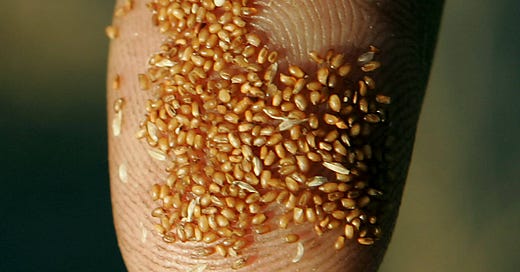Connect your brand to the farm system
Buyers are looking to bring in brands that will change farming
3-min read
You might be 1% for the plant and that’s great, but if you can connect upstream to who you source from – that’s even better.
Farm. System. Change.
It’s all over the news. Buyers are looking to bring in brands that align with this trend.
I want to continue the conversation on demand driven agriculture (if you missed the last two newsletters, go back) by focusing on our nation’s top ag commodity market – the grain market.
There is a global grain shortage. At the same time, growers are being pressured (and incented) towards regenerative practices by corporates and public agencies that say “plant cover crops” and “diversify”. It’s become a matter of national security that we figure out the fertilizer problem. Specialty grains, or ancient grains as they are sometimes called, require less fertilizer and irrigation. These include teff, einkorn, buckwheat, and amaranth.
Consumer driven change: getting the attention of buyers
You have about three minutes with a buyer. In the first minute you must cover ingredient sourcing. If you source direct from a farmer – or you are the farmer – say something.
“This single sentence, ‘We are sourcing ingredients from our 7th generation family farm where we are pivoting from corn and soy to ancient grains and seeds’, buys me more time with the buyer” says Claire Smith, founder of the granola brand Teffola.
Food system change as a grassroots effort
Consumers want better nutrition from sustainable sources, and that puts monoculture in the hot seat. Enter ancient grains.
The global ancient grains market is growing but still tiny (will reach $6.2b by 2026), and is dominated by developing countries whose farming practices and supply chain are hugely inefficient. Brands whose mission it is to help subsistence farmers in Africa are bringing awareness to ancient grains by marketing here in the US (Yolele is doing this for fonio). Lil’ Bucks buys domestic buckwheat and talks about the importance of supporting sustainable farming in the US.
Until there is a large enough market, ag looks at new opportunities as either a hedge or an investment. Crop diversification is usually a hedge. And that is the story of Tenera Farms, where Teffola was born.
Source: huffingtonpost.ca
Teff leads all the grains – by a wide margin – in its calcium content, with a cup of cooked teff offering 123 mg, about the same amount of calcium as in a half-cup of cooked spinach. It's also an excellent source of vitamin C, a nutrient not commonly found in grains
From farmer to processor to manufacturer
Tenera Farms of Michigan started growing this obscure grain to hedge the volatile commodity grain market. They wanted to create a more reliable income stream for themselves and eventually create a big enough market for neighboring farms to join in. What they found is teff grows great! But marketing teff as an ingredient (which was their aim) was not great.
No one knows what to do with teff flour (it is used to make the Ethiopian bread injera). So Claire starting making this delicious granola and she also added buckwheat, another amazingly nutritious and carbon-sequestering crop that grows easily. So Tenera Farms started growing buckwheat too.
“Oat based granolas are so boring”, Claire Smith, Teffola.
When they couldn’t find anyone nearby to hull and clean the grain, they became the processor too.
While consumers may not know what teff is or even be familiar with buckwheat (which is not wheat at all!) everyone knows what granola is. The multiple grains in Teffola brings interest through texture and depth of flavor unlike single grain oat granolas.
Controlling the entire supply chain is a huge sell-in story with buyers
Local has never meant more than it does today. Not many of us can say we are the farmer, but we certainly can and should trace our key ingredients back to the farm and tell the sustainability story. Teffola is still a young brand, but it is proving out that specialty grains as crops can flourish in the Midwest and be good for farmers as a business.
That is Farm. System. Change.
All my best,
Jennifer






